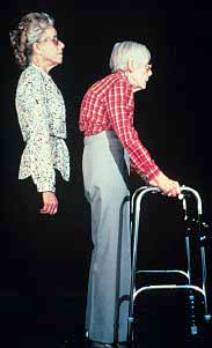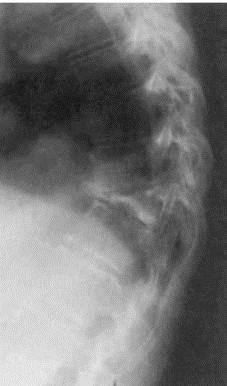Description:
- Osteoporosis is a decline in overall bone mass in the axial and appendicular skeleton
- Affects 15-20 million people in the US
- Peak bone mass is reached between ages 16-25 years
- With age, bone resorption exceeds bone formation
- Women are at increased risk in the 15-20 years after menopause, directly linked to estrogen deficiency
- Certain environmental factors may accelerate osteoporosis:
- Chronic calcium deficiency
- Smoking
- Excessive alcohol intake
- Hyperparathyroidism
- Inactivity
- Genetic influences
- Vertebral compression fractures are one of most frequent manifestations of osteoporosis in elderly with >700,000 compression fractures annually
- Most patients are asymptomatic

Signs/Symptoms:
- Symptomatic compression fractures involve pain localized to fractured level
- Frequently no history of trauma or inciting event
- Often family members will notice the patient’s back becoming progressively more rounded (kyphotic)
- This spinal deformity is known as “dowager’s hump” (right)
- Generally there is no neurologic dysfunction and no radiation of pain in dermatomal patterns
Imaging:
- Plain radiographs and densitometric scans are major imaging modalities
- Dual-energy x-ray absorptiometry (DEXA scan) has been most useful form of densitometric scans due to its high presicion (0.5-2%) and minimal amounts of radiation
- DEXA scan assesses and quantitates osteoporosis
- AP & Lateral plain films of affected area demonstrate severity of osteoporotic fractures(s)
- MRI is valuable in evaluation of persistently painful, non-united, or pathologic fractures
- MRI is also helpful in determining the acuity of a compression fracture seen on plain film
Severe T-11 compression fracture with marked wedging and kyphosis

Treatment:
- Osteoporosis
- Prevention is the best treatment for osteoporosis
- Maximizing bone density prior to onset of bone loss is optimal regimen
- Estrogen replacement is controversial but is effective at halting the post-menopausal decline in bone density in women
- Calcitonin and parathyroid hormone are effective therapies in certain patients
- Bisphosphonates (etidronate and alendronate) prevent osteoclastic resorption of bone
- Bisphosphonates are the only FDA approved pharmacotherapy for increasing bone density. Unfortunately, the increase is small
Vertebral Compression Fractures
- Initial treatment involves analgesics therapy and bracing for comfort
- Evaluation and treatment for osteoporosis should be initiated
- Surgical treatment is required compression fractures with associated neurologic compromise or spinal cord compression
- Anterior decompression and fusion with possible posterior fusion
- Patients with persistent pain after conservative therapy may undergoe percutaneous stabilizing techniques
- polymethylmethacrylate (PMMA) bone cement is injected into the fracture percutaneously through pedicles into vertebral body under fluoroscopic guidance
- Vertebroplasty
- Kyphoplasty
- Both methods show excellent symptomatic relief and have shown to be safe and efficacious

